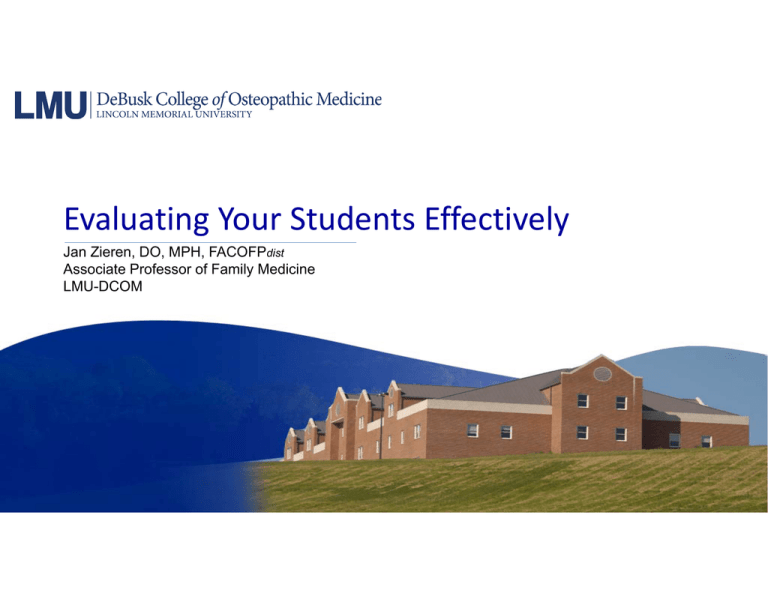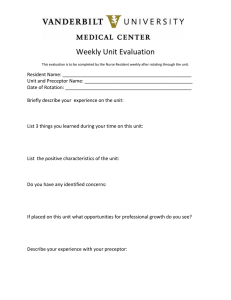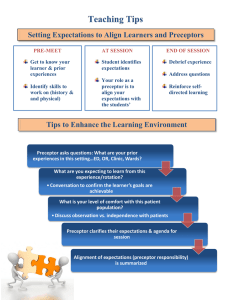Evaluating Your Student 20156online
advertisement

Evaluating Your Students Effectively Jan Zieren, DO, MPH, FACOFPdist Associate Professor of Family Medicine LMU-DCOM I am sorry if my student was a bit much…. Learning Objectives At the end of the presentation the participant will be able to: Identify methods of evaluation Examine the effectiveness of various evaluation methods Understand the challenges and successes of learner feedback One of the most critical components of effective precepting is effectively evaluating your learners… ASSESSMENT • Process of gathering data • Measures learning & effectiveness of teaching • Identify areas needing improvement • Utilize data for feedback/facilitation • At beginning and during teaching EVALUATION • Judgment based on gathered data • Rubrics define more objective grades • Grading a status at a given end point • Mid‐point and End‐of‐rotation evaluations Northern Illinois University http://facdev.niu.edu ASSESSMENT DIAGNOSTIC ASSESSMENT FORMATIVE ASSESSMENT SUMMATIVE ASSESSMENT Northern Illinois University http://facdev.niu.edu DIAGNOSTIC ASSESSMENT • Identify student’s current knowledge/skill sets/learning style • Clarify misconceptions before teaching takes place • Knowing learning strengths and weaknesses allows personalized teaching methods and techniques Diagnostic Assessment Techniques Pretests Self‐assessments Interviews Direct Observation Assessment tools Checklists Learning Contract Student self‐evaluation – desired objectives / methods Stakeholder in development and outcome First step to life‐long self‐directed learning Preceptor diagnostic evaluation ‐ (student knowledge / skills / learning style) – suggested objectives and methods • Discuss & create evaluation rubric – DCOM expectations ‐ rotation goals – student needs • • • • FORMATIVE ASSESSMENT • • • • • Measures student’s progress Provides feedback and information during the learning process Determines teaching effectiveness Focuses on the process toward the end of the “product” Primarily identifies areas that need improvement Northern Illinois University http://facdev.niu.edu Types of Formative Assessment Methods Observation Homework exercises Journals Question and answer sessions Conferences Student presentations Self evaluation Student feedback Rubric Clinical assessment models RIME Model • • • • REPORTER – Understands what is wrong with the patient INTERPRETER – Understands why something is wrong MANAGER – Understands how to address the problem EDUCATOR – Understands deeply, informs the team and is committed to continued, self‐learning Assesses progress of a learner – in a consistent manner – provides timely, nonjudgmental feedback MILLER ASSESSMENT PYRAMID FEEDBACK Technically part of teaching Utilizes the information gathered from assessment Document ongoing assessments/feedback for final evaluation Stress the positive – facilitate/guide student with correction Make comments information‐specific, issue‐focused and based on observation • Not a one‐way process ‐ compare assessment with learner’s experience/viewpoint • • • • • FEEDBACK LEVELS • Level 1 ‐ description of learner’s behavior without judgment • Level 2 ‐ expression of feelings triggered by learner’s behavior • Level 3 – prediction of the likely outcome of a behavior www.teachingphysician.org FEEDBACK MODELS • • • • SANDWICH MODEL ASK‐TELL‐ASK MODEL ARCH MODEL FIVE‐STEP MICROSKILLS (One Minute Preceptor) www.teachingphysician.org FEEDBACK TIMING • • • • Each encounter Daily Weekly Mid‐rotation Provide frequent, prompt and facilitative assessment throughout the course as a guide to future learning. Mid‐rotation Review • • • • • • Progress report Share “room for improvement” “Thermometer” to guide the rest of the rotation Ask for a self‐assessment from the student Review course goals and objectives Request feedback from learner – including ideas to improve learning experience FEEDBACK PEARLS • Document observations, examples, and feedback moments • Use feedback and conversations to create evidence, examples and observational support for the summative evaluation • Collect student feedback periodically (of instruction, self‐ evaluation and progress) • Use different types of feedback • Give feedback as soon as possible related to the behavior • Limit the amount of information FEEDBACK TRAPS • Avoid reviewing from a self perspective • Don’t base feedback of a learner on unrelated factors • Be aware of learner shifting attention back to preceptor (to derail feedback) • Don’t give feedback if angry • Use multiple observation or measurement tactics (or even more than one evaluator) • Steer clear of artificial barriers SUMMATIVE ASSESSMENT • • • • Sums up teaching as well as the learning After learning has been completed – end of rotation evaluation Product‐oriented – assesses the final results or achievements Rubrics can be used (developed at onset of rotation around set of standards or expectations) Northern Illinois University http://facdev.niu.edu ASSESSMENT OPTIONS FOR EVALUATION • • • • • • Papers Projects Portfolios Performance Examinations Student self evaluation Preceptor & Colleagues 360‐degree Evaluation of Student NP or PA Patients Nurses & Medical Assistants SELF Other Staff FORMAL REVIEW • End of Rotation = summative evaluation of the data collected in formative assessments • Base on multiple observers if possible • Qualitative and Quantitative information • DCOM has form online • Space for written comments WRITTEN COMMENTS • • • • • General Comments (strengths & weaknesses) Understanding Skill Knowledge Attitude • To give feedback that motivates changes in the student • To equip the preceptor for a facilitator role with meaningful instructional correction techniques • To spur the student toward adult learning – critical thinking and self‐ directed, life‐long learning • To turn a systematic process into quality teaching with effective evaluation • To allow the preceptor to become more effective as a one‐on‐one mentor • To guide the preceptor in designing education sessions that meet the learning objectives EFFECTIVENESS… • • • • • • • • Goals met on Learning Contract? Rubric objectives completed? Skills achieved? Improvement in knowledge level? Student built learner confidence? Improvement in student self‐reflection/assessment ability? Student motivated to self‐directed life‐long learning mode? How well did student perform on SHELF exam or COMLEX? Challenges with Learners CONCERNS TO DO • Categorize the issue or problem • Problematic behavior? • Struggling or progressing more slowly than others? • Ongoing or new onset? • Attitude problems? • Lack of skill or knowledge issues? • Have a private discussion with learner • Focus on behavior that can change • Is the problem important enough to address? • Work on plan for learner • Seek outside help if necessary • Notify the Clinical Rotations Office Beyond Student Evaluation… • • • • • Student will be evaluating the course and preceptor Opportunity to have feedback on your teaching skills Solicit feedback from student Assessing student’s success reflects teaching success Self‐evaluation throughout the rotation ROTATION Diagnostic Assessment Learning contract Formative Assessment Feedback MID‐ROTATION EVALUATION Feedback Summative Assessment End of Rotation Evaluation

